The NVIDIA GeForce RTX 2080 Ti & RTX 2080 Founders Edition Review: Foundations For A Ray Traced Future
by Nate Oh on September 19, 2018 5:15 PM EST- Posted in
- GPUs
- Raytrace
- GeForce
- NVIDIA
- DirectX Raytracing
- Turing
- GeForce RTX
The RTX Recap: A Brief Overview of the Turing RTX Platform
Overall, NVIDIA’s grand vision for real-time, hybridized raytracing graphics means that they needed to make significant architectural investments into future GPUs. The very nature of the operations required for ray tracing means that they don’t map to traditional SIMT execution especially well, and while this doesn’t preclude GPU raytracing via traditional GPU compute, it does end up doing so relatively inefficiently. Which means that of the many architectural changes in Turing, a lot of them have gone into solving the raytracing problem – some of which exclusively so.
To that end, on the ray tracing front Turing introduces two new kinds of hardware units that were not present on its Pascal predecessor: RT cores and Tensor cores. The former is pretty much exactly what the name says on the tin, with RT cores accelerating the process of tracing rays, and all the new algorithms involved in that. Meanwhile the tensor cores are technically not related to the raytracing process itself, however they play a key part in making raytracing rendering viable, along with powering some other features being rolled out with the GeForce RTX series.
Starting with the RT cores, these are perhaps NVIDIA’s biggest innovation – efficient raytracing is a legitimately hard problem – however for that reason they’re also the piece of the puzzle that NVIDIA likes talking about the least. The company isn’t being entirely mum, thankfully. But we really only have a high level overview of what they do, with the secret sauce being very much secret. How NVIDIA ever solved the coherence problems that dog normal raytracing methods, they aren’t saying.
At a high level then, the RT cores can essentially be considered a fixed-function block that is designed specifically to accelerate Bounding Volume Hierarchy (BVH) searches. BVH is a tree-like structure used to store polygon information for raytracing, and it’s used here because it’s an innately efficient means of testing ray intersection. Specifically, by continuously subdividing a scene through ever-smaller bounding boxes, it becomes possible to identify the polygon(s) a ray intersects with in only a fraction of the time it would take to otherwise test all polygons.
NVIDIA’s RT cores then implement a hyper-optimized version of this process. What precisely that entails is NVIDIA’s secret sauce – in particular the how NVIDIA came to determine the best BVH variation for hardware acceleration – but in the end the RT cores are designed very specifically to accelerate this process. The end product is a collection of two distinct hardware blocks that constantly iterate through bounding box or polygon checks respectively to test intersection, to the tune of billions of rays per second and many times that number in individual tests. All told, NVIDIA claims that the fastest Turing parts, based on the TU102 GPU, can handle upwards of 10 billion ray intersections per second (10 GigaRays/second), ten-times what Pascal can do if it follows the same process using its shaders.
NVIDIA has not disclosed the size of an individual RT core, but they’re thought to be rather large. Turing implements just one RT core per SM, which means that even the massive TU102 GPU in the RTX 2080 Ti only has 72 of the units. Furthermore because the RT cores are part of the SM, they’re tightly couple to the SMs in terms of both performance and core counts. As NVIDIA scales down Turing for smaller GPUs by using a smaller number of SMs, the number of RT cores and resulting raytracing performance scale down with it as well. So NVIDIA always maintains the same ratio of SM resources (though chip designs can very elsewhere).
Along with developing a means to more efficiently test ray intersections, the other part of the formula for raytracing success in NVIDIA’s book is to eliminate as much of that work as possible. NVIDIA’s RT cores are comparatively fast, but even so, ray interaction testing is still moderately expensive. As a result, NVIDIA has turned to their tensor cores to carry them the rest of the way, allowing a moderate number of rays to still be sufficient for high-quality images.
In a nutshell, raytracing normally requires casting many rays from each and every pixel in a screen. This is necessary because it takes a large number of rays per pixel to generate the “clean” look of a fully rendered image. Conversely if you test too few rays, you end up with a “noisy” image where there’s significant discontinuity between pixels because there haven’t been enough rays casted to resolve the finer details. But since NVIDIA can’t actually test that many rays in real time, they’re doing the next-best thing and faking it, using neural networks to clean up an image and make it look more detailed than it actually is (or at least, started out at).
To do this, NVIDIA is tapping their tensor cores. These cores were first introduced in NVIDIA’s server-only Volta architecture, and can be thought of as a CUDA core on steroids. Fundamentally they’re just a much larger collection of ALUs inside a single core, with much of their flexibility stripped away. So instead of getting the highly flexible CUDA core, you end up with a massive matrix multiplication machine that is incredibly optimized for processing thousands of values at once (in what’s called a tensor operation). Turing’s tensor cores, in turn, double down on what Volta started by supporting newer, lower precision methods than the original that in certain cases can deliver even better performance while still offering sufficient accuracy.
As for how this applies to ray tracing, the strength of tensor cores is that tensor operations map extremely well to neural network inferencing. This means that NVIDIA can use the cores to run neural networks which will perform additional rendering tasks. in this case a neural network denoising filter is used to clean up the noisy raytraced image in a fraction of the time (and with a fraction of the resources) it would take to actually test the necessary number of rays.
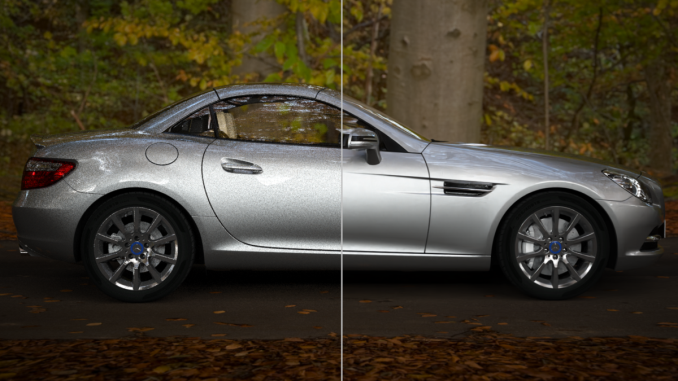
No Denoising vs. Denoising in Raytracing
The denoising filter itself is essentially an image resizing filter on steroids, and can (usually) produce a similar quality image as brute force ray tracing by algorithmically guessing what details should be present among the noise. However getting it to perform well means that it needs to be trained, and thus it’s not a generic solution. Rather developers need to take part in the process, training a neural network based on high quality fully rendered images from their game.
Overall there are 8 tensor cores in every SM, so like the RT cores, they are tightly coupled with NVIDIA’s individual processor blocks. Furthermore this means tensor performance scales down with smaller GPUs (smaller SM counts) very well. So NVIDIA always has the same ratio of tensor cores to RT cores to handle what the RT cores coarsely spit out.
Deep Learning Super Sampling (DLSS)
Now with all of that said, unlike the RT cores, the tensor cores are not fixed function hardware in a traditional sense. They’re quite rigid in their abilities, but they are programmable none the less. And for their part, NVIDIA wants to see just how many different fields/tasks that they can apply their extensive neural network and AI hardware to.
Games of course don’t fall under the umbrella of traditional neural network tasks, as these networks lean towards consuming and analyzing images rather than creating them. None the less, along with denoising the output of their RT cores, NVIDIA’s other big gaming use case for their tensor cores is what they’re calling Deep Learning Super Sampling (DLSS).
DLSS follows the same principle as denoising – how can post-processing be used to clean up an image – but rather than removing noise, it’s about restoring detail. Specifically, how to approximate the image quality benefits of anti-aliasing – itself a roundabout way of rendering at a higher resolution – without the high cost of actually doing the work. When all goes right, according to NVIDIA the result is an image comparable to an anti-aliased image without the high cost.
Under the hood, the way this works is up to the developers, in part because they’re deciding how much work they want to do with regular rendering versus DLSS upscaling. In the standard mode, DLSS renders at a lower input sample count – typically 2x less but may depend on the game – and then infers a result, which at target resolution is similar quality to a Temporal Anti-Aliasing (TAA) result. A DLSS 2X mode exists, where the input is rendered at the final target resolution and then combined with a larger DLSS network. TAA is arguably not a very high bar to set – it’s also a hack of sorts that seeks to avoid doing real overdrawing in favor of post-processing – however NVIDIA is setting out to resolve some of TAA’s traditional inadequacies with DLSS, particularly blurring.
Now it should be noted that DLSS has to be trained per-game; it isn’t a one-size-fits all solution. This is done in order to apply a unique neutral network that’s appropriate for the game at-hand. In this case the neural networks are trained using 64x SSAA images, giving the networks a very high quality baseline to work against.
None the less, of NVIDIA’s two major gaming use cases for the tensor cores, DLSS is by far the more easily implemented. Developers need only to do some basic work to add NVIDIA’s NGX API calls to a game – essentially adding DLSS as a post-processing stage – and NVIDIA will do the rest as far as neural network training is concerned. So DLSS support will be coming out of the gate very quickly, while raytracing (and especially meaningful raytracing) utilization will take much longer.
In sum, then the upcoming game support aligns with the following table.
| Planned NVIDIA Turing Feature Support for Games | |||||
| Game | Real Time Raytracing | Deep Learning Supersampling (DLSS) | Turing Advanced Shading | ||
| Ark: Survival Evolved | Yes | ||||
| Assetto Corsa Competizione | Yes | ||||
| Atomic Heart | Yes | Yes | |||
| Battlefield V | Yes | ||||
| Control | Yes | ||||
| Dauntless | Yes | ||||
| Darksiders III | Yes | ||||
| Deliver Us The Moon: Fortuna | Yes | ||||
| Enlisted | Yes | ||||
| Fear The Wolves | Yes | ||||
| Final Fantasy XV | Yes | ||||
| Fractured Lands | Yes | ||||
| Hellblade: Senua's Sacrifice | Yes | ||||
| Hitman 2 | Yes | ||||
| In Death | Yes | ||||
| Islands of Nyne | Yes | ||||
| Justice | Yes | Yes | |||
| JX3 | Yes | Yes | |||
| KINETIK | Yes | ||||
| MechWarrior 5: Mercenaries | Yes | Yes | |||
| Metro Exodus | Yes | ||||
| Outpost Zero | Yes | ||||
| Overkill's The Walking Dead | Yes | ||||
| PlayerUnknown Battlegrounds | Yes | ||||
| ProjectDH | Yes | ||||
| Remnant: From the Ashes | Yes | ||||
| SCUM | Yes | ||||
| Serious Sam 4: Planet Badass | Yes | ||||
| Shadow of the Tomb Raider | Yes | ||||
| Stormdivers | Yes | ||||
| The Forge Arena | Yes | ||||
| We Happy Few | Yes | ||||
| Wolfenstein II | Yes | ||||


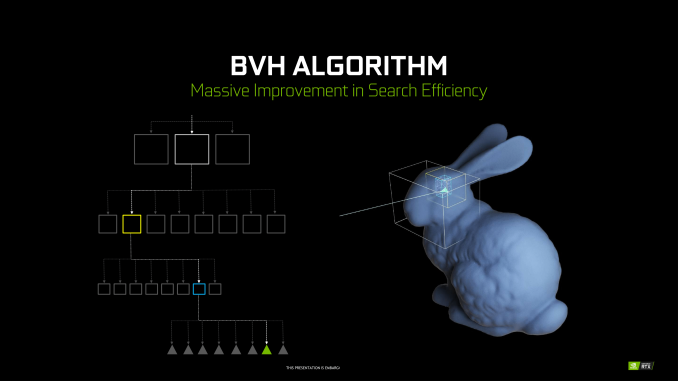
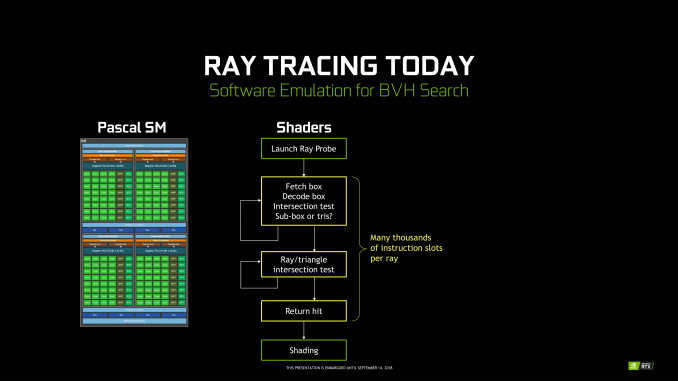
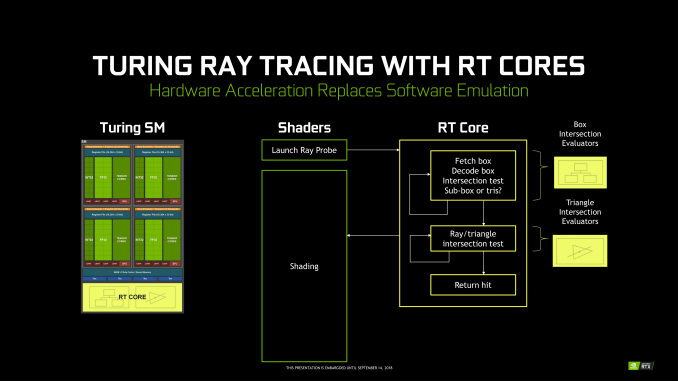
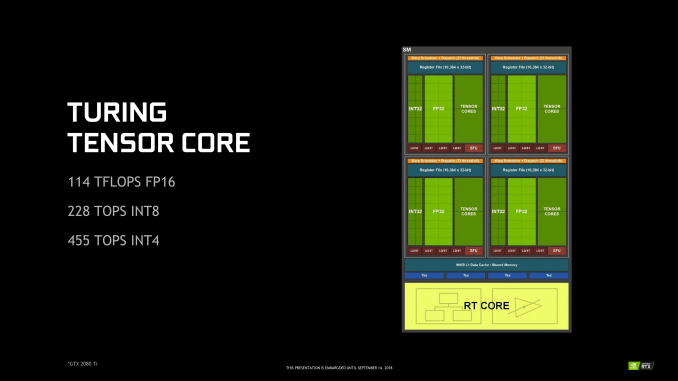
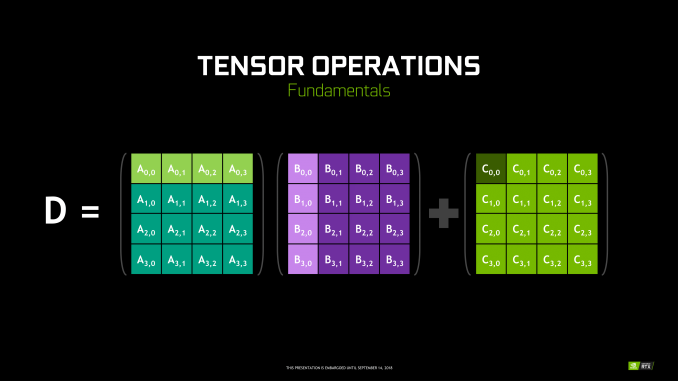
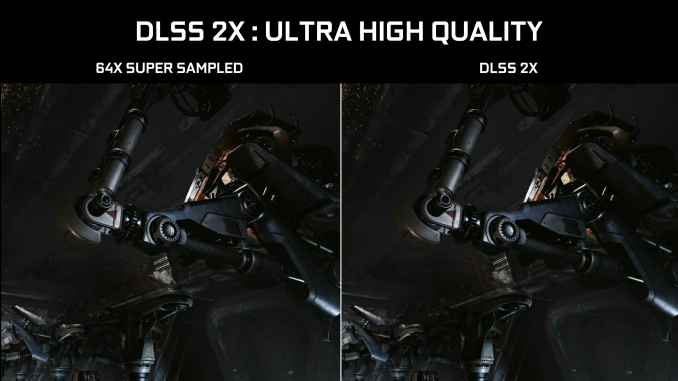








337 Comments
View All Comments
Dribble - Thursday, September 20, 2018 - link
The DLSS basically gives you a resolution jump for free (e.g. 4k for 1440p performance) and is really easy to implement. That's going to take off fast and probably means even the 2070 will be faster then the 1080Ti in games that support it.Lolimaster - Saturday, September 22, 2018 - link
No not free, everyone can see the blurry mess the renamed blur effect is.Inteli - Saturday, September 22, 2018 - link
TIL that when you stop isolating variables in a benchmark, a lower-end card can be faster than a higher-end card.tamalero - Wednesday, September 19, 2018 - link
Die size is irrelevant to consumers. They see price vs performance. not how big the silicon is.AMD was toasted for having hot slow chips. many times.. so did nvidia.. big and hot means nothing if it doesn't perform as expected for the insane prices they 're asking for.
Yojimbo - Wednesday, September 19, 2018 - link
Die size is not irrelevant to consumers because increased die size means increased cost to manufacture. Increased cost to manufacture means a pressure for higher prices. The question is what you get in return for those higher prices.People like what they know... what they are used to. If some new AA technique comes along and increases performance significantly but introduces visual artifacts it will be rejected as a step backwards. But if a new technology comes along that has a significant performance cost yet increases visual quality much more significantly than the aforementioned artifacts decrease it, people will also have a tendency to reject it. That is, until they become familiar with the technology... That's where we are with RTX. No one can become familiar with the technology when there are no games that make use of it. So trying to judge the value of the larger die sizes is an abstract thing. In a few months the situation will be different.
Personally, I think the architecture will be remembered as one of the biggest and most important in the entire history of gaming. There is so much new technology in it that some of it barely anyone is saying much about (where have you heard about texture space shading, for example?). Several of these technologies will have their greatest benefits with VR, and if VR had taken off people would be marveling about this architecture immediately. But I think that VR will eventually take off, and I think several of these technologies will become the standard way of doing things for the next several years. They are new and complicated for developers, though. Only a few developers are prepared to take advantage of the stuff today. It's going to be some time before we really can put the architecture into its proper historical perspective.
From the point of view of a purchase today, though, it's a bit of an unknown. If you buy a card now and plan to keep it for 4 years, I think you'd be better off getting a 20 series than a 10 series. If you buy it and keep it for 2 years, then it's a bit less clear, but we'll have a better idea of the answer to that question in 6 months, I think.
I do think, though, that if an architecture with this much new stuff were introduced 20 years ago everybody, including games enthusiast sites like Anandtech, would be going gaga over it. The industry was moving faster then and people were more optimistic. Also the sites didn't try to be so demure. Hmm, gaga as the opposite of demure. Maybe that's why she's called Lady Gaga.
Santoval - Wednesday, September 19, 2018 - link
I agree that this might be the most game-changing graphics tech of the last couple of decades, and that the future belongs to ray-tracing, but I also think that precisely due to the general uncertainty and the very high prices Nvidia might suffer one of their biggest sales slumps this generation, if not *the* biggest. They did not handle the launch well : it is absurd to release a new series with zero ray-traced, DLSS supporting or mesh shaded games at launch.Their extensive NDAs, lack of information and ban on benchmarks between the Gamescom pre-launch and the actual launch, despite going live with (blind faith based) preorders during that window, was also controversial and highly suspicious. It appears that Nvidia gave graphics cards to game developers very late to avoid leaks, but that resulted in having no RTX supporting games at launch. They thought they could not have it both ways apparently, but choosing that over having RTX supporting games at launch was a very risky gamble.
Since their sales will almost certainly slump, they should release 7nm based graphics cards (either a true 30xx series or Turing at 7nm, I guess the latter) much sooner, probably in around 6 months. They might have expected a sales slump, which is why they released 2080Ti now. I suppose they will try to avoid it with aggressive marketing and somewhat lower prices lately, but it is not certain they'll succeed.
eddman - Thursday, September 20, 2018 - link
Would you've still defended this if it was priced at $1500? How about $2000? Do you always ignore price when new tech is involved?The cards, themselves, aren't bad. They are actually very good. It's their pricing.
These cards, specifically 2080 Ti, are overpriced compared to their direct predecessors. Ray tracing, DLSS, etc. etc. they still do not justify such prices for such FPS gains in regular rasterized games.
A 2080 Ti might be an ok purchase for $850-900, but certainly not $1200+. Even 8800 GTX with its new cuda cores and new generation of lighting tech launched at the same MSRP as 7800 GTX.
These cards are surely more expensive to make, but there is no doubt that the biggest factor for these price jumps is that nvidia is basically competing with themselves. Why price them lower when they can easily sell truckloads of pascal cards at their usual prices until the inventory is gone.
Andrew LB - Thursday, September 20, 2018 - link
You, like so many others don't get it. nVidia has re-worked their product lines. Didn't you notice how the Ti came out at the same time as the 2080? You might also notice that Titan is now called Titan V (volta) and not GTX Titan. Titan is now in its own family of non-gaming cards and that is reflected in the driver section on their site. They now have titan specific drivers.Here, watch this. Jay explains it fairly well.
https://youtu.be/5XRWATUDS7o?t=6m2s
eddman - Thursday, September 20, 2018 - link
You took an opinion and decided it's a fact. It's not. That guy is not the authority on graphics cards.There is no official word that titan is now 2080 Ti. Nvidia named that card 2080 Ti, it has a 102 named chip. Nvidia themselves constantly compare it to 1080 Ti, which also has a 102 named chip, therefore it's the successor to 1080 Ti and it's very normal to expect similar pricing.
Don't worry, there will be a Titan turing, considering that 2080 Ti does not even use the fully enabled chip.
It's really baffling to see people, paying customers, defending a $1200 price tag. It is as if you like to be charged more.
eddman - Thursday, September 20, 2018 - link
$1000, but it's still too high, and you cannot find any card at that price anyway.